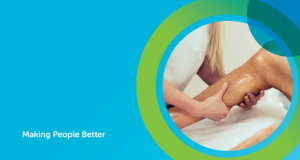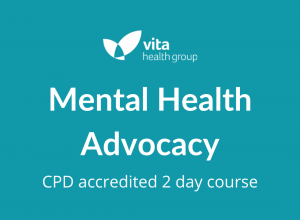Introduction
The Introduction to Exercise Class aims to help you get used to doing some new movements with your body and show you how to improve your joint movement, muscle power, flexibility and balance, so that you can get moving again and think about what sort of exercise you might enjoy in the future, to keep your body working as well as it can. Having looked at the difficulties and / or pain you are experiencing, we are offering you this as the best and quickest way to improve the way you are feeling.
What to expect
This is a physical, progressive exercise rehabilitation group. The group usually consists of up to 12 people, who are at varying stages of recovery for a variety of problems. The therapist will confirm some details with you at the start of the class and provide you with information on what to expect. You will be monitored and guided through the exercises and with time you will become familiar and more confident. We would like you to attend 4 regular sessions and it is important to practice these exercises at home in between sessions and once your treatment has finished.
What will I need?
- Wear loose fitting clothing that is comfortable to move in
- Wear supportive footwear such as trainers
- You may wish to bring a drink
Read our FAQs for more information about our classes and what to expect.
Self-help exercises
Try to find 5-10 minutes in your daily routine to complete some of these exercises, choosing 3-4 different ones each time to practice.
To make progress with your recovery, each exercise should be easy and comfortable at the start but slightly uncomfortable by the end, with the discomfort easing within 10 minutes of finishing.
If it is too hard (very uncomfortable or doesn’t ease off) do less repetitions or the easier version next time. If it is too easy (doesn’t get uncomfortable by the end) do more repetitions or the harder version of the exercise next time. The exercises provided are a guide and not all of them may be appropriate for you. Speak to your therapist for specific guidance on your home program or if you have any concerns with any of the exercises.
Exercise 1
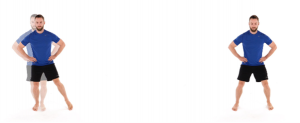
Stand up and take a side step with one leg. Then bring the leg back to the starting position.
+ To make it harder raise both hands in the air as high as you can as you step out, then bring them back as you step back.
– To make it easier take a side step with one leg then follow on with the other to bring feet together again. Then side step with the other leg leading to go back to the start point.
Exercise 2
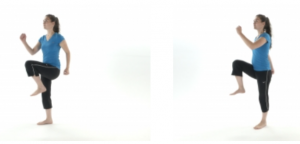
Stand up with your feet about hip width.
March on the spot, lifting your knees high.
Keep the body straight as you do the exercise.
+ To make it harder punch right up into the air instead of just lifting your hands to shoulder height
– To make it easier steady yourself with one hand on the back of a chair and just use your legs to march.
Exercise 3
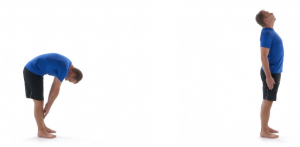
Stand up and bend forwards from the top to the bottom of the spine, starting with your upper vertebra all the way to the lower vertebra.
Keep your knees straight and bend as far as you will go, focusing on each separate bone in you back to move.
Extend back up with the reverse motion, extending your spine at the top of the movement.
+ To make it harder push and hold the stretch at the end of your range
– To make it easier just go gently to where you feel comfortable, even if it’s just looking down and bending forwards a bit
Exercise 4
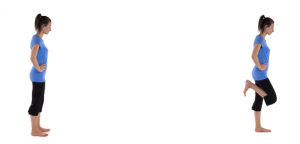
Standing, bend your knee to bring the heel to your bottom. Keep your pelvis and trunk as still as you can and the knee pointing downwards.
Repeat on the other side.
+ To make this harder; after you have brought your heel to your bottom stretch it out straight behind you, then bring it back to your bottom and put it back down to the floor again.
– To make this easier hold onto the back of a chair with one hand.
Exercise 5
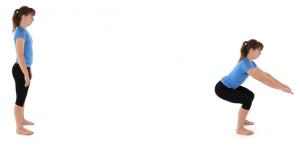
Stand with both feet hip width apart and facing forward.
Slowly lower your body into a squat position (as if you are sitting on an imaginary chair) while keeping your back straight and your knee caps going forwards over your toes. Try to keep your heels on the ground.
Push through your heels and activate your bottom muscles to come back to standing.
Repeat.
+ To make it harder as you come back up to standing rise up on tip toes then lower back down before you do your next squat.
– To make it easier hold on to the back of a chair
Exercise 6
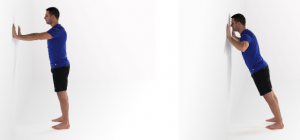
Stand at one arm’s length from a wall and place your hands on the wall.
Bend your arms and lean your upper body forward slowly.
Straighten your arms and push your upper body back.
Keep your body in a straight line; stop your lower back from arching by activating your tummy and bottom muscles.
+ To make this harder stand further away from the wall (or at home use a lower surface such as a worktop)
– To make this easier stand a bit closer to the wall.
Exercise 7
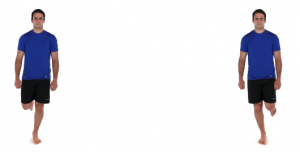
Stand straight with your feet close together and lift one leg off the floor. Hold for a slow count of 30, lower your leg and repeat with the opposite leg.
+ To make this harder touch your hands together as high above your head as you can whilst standing on one leg.
– To make this easier use one finger resting on the back of a chair to help keep your balance.
Exercise 8
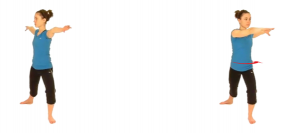
Stand with feet apart, right foot pointing forward, and left leg with knee bent, toes pointing towards the left. Most of your weight should be on the left leg. Bring your arms up to hold them out to the sides at shoulder height.
Keep your left arm where it is and twist your body to bring your right arm round to meet it.
Return slowly to the starting position, then repeat on the other side;
Right toes pointing out right, bent right leg with most of your weight on it, arms out to the side. This time bring the left hand round to meet the right one.
+ To make this harder take your feet further apart and bend your knees deeper
– To make it easier bring your feet closer together
Physical activity reduces the chances of major illness
The importance of being active
NHS guidleines recommend the following:
- 150mins moderate intensity exercise a week
- 30mins x 5 = Weekly recommended activity
- Moderate intensity = any exercise that elevates the heart/ breathing rate to a point where you can still hold a conversation 75mins of intense exercise a week
- 15mins x 5 = Weekly recommended activity
- Intense exercise = any exercise that elevates heart rate
Physical benefits include
- Energy levels increased
- Increased physical strength
- Completing longer walks
- Grants you some more ability to do more things that you may enjoy Decreases chance of developing OA by 83%
Mental benefits include
- Stimulates Release of dopamine and serotonin
- Improving mood
- Reduces Stress
- Improves sleep – Serotonin has been shown to be assistive with sleep regulation
- Better digestion – Lower Serotonin presence in the gut is found to correlate with constipation
- Health is a state of complete physical, mental and social well-being and not merely the absence of disease or infirmity”. WHO
Vita is an award-winning, CQC registered healthcare provider













